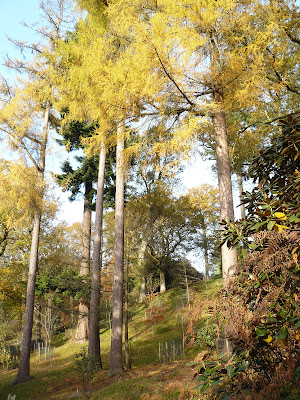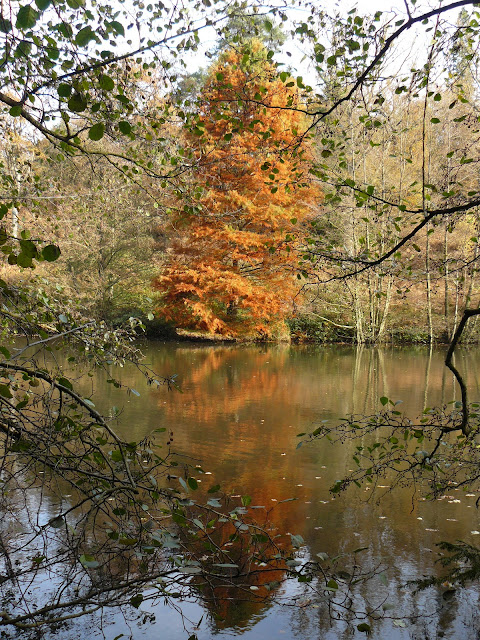For illustrated talks on natural history and history see www.peterlovetttalks.co.uk
For illustrated talks on natural history and history click here for www.peterlovetttalks.co.uk
Monday, 15 November 2010
The Sunny High Weald
When the weather forecast is for fog, it is a pleasure to be high enough in the High Weald to be able to look across the foggy Low Weald to Chanctonbury Hill, emerging from the fog line.
Wednesday, 10 November 2010
Save our Badgers
Contrary to all the scientific evidence, the government seems intent on needlessly culling badgers. Please visit www.badgertrust.org.uk and www.Save-Me.org.uk to make your voice heard, if you no longer believe in outdated ideas like burning witches or culling badgers.
Sunday, 7 November 2010
Deciduous conifers at Wakehurst Place
Tomorrow the winds and rain may strip these trees of their needles and colours. So I thought to share these pictures with you. Above is the European larch.
Click on any picture to enlarge it.
Quite different from our European larch is....
Above is a larch from Japan.
It is not just the larch family of conifers that are deciduous, above is the Dawn Redwood.
The most spectacular colour is the Swamp cypress
Here is another specimen. Enjoy!
Click on any picture to enlarge it.
Quite different from our European larch is....
Above is a larch from Japan.
It is not just the larch family of conifers that are deciduous, above is the Dawn Redwood.
The most spectacular colour is the Swamp cypress
Here is another specimen. Enjoy!
Wednesday, 3 November 2010
A Jurassic coast walk from Seaton to Sidmouth, 2nd November 2010
The Jurassic coast and the South West coastal path in Devon are awesome. We took a bus from from Sidmouth to Seaton, from whence we started our walk.
There is typically 160m of ascent and descent into and out of these beaches.
These hills are hard work.
A section of reasonably level woodland with epiphytic ferns was a welcomed "rest".
There is a way to go yet to Sidmouth.
And the valleys yet to be traversed are high and steep!
The ravens were always entertaining.
We now have to go down to the beach.... and, of course, up 160m to the other side.
Now we have to get back up to the top of the cliff.
That was a hard climb, believe me.
Salcombe mouth and just one more vicious climb to go.
These pretty cows were friendlier than they looked. All along this route, the animals are so used to walkers that they ignore you to the point where heifers will walk down a steep set of steps and expect you to get out of their way! I had to shout a bit -- politely -- to continue walking at one point, where steers and heifers blocked the path.
This fine mushroom might be a Parasol, which is delicious to eat...

...or it might be a Freckled Dapperling, which is mildly poisonous.
I have eaten both and can not recommend the latter.
Note the white patch on the hill, that we walked right past. Below is the explanation.
After nearly six hours walking, this final valley was draining of any energy that we had left. At least Sidmouth was in sight.
Ahhhh! Sidmouth and civilisation.
Nearly there, to the welcoming luxury of the Hotel Riviera.
The Hotel Riviera is one of the finest hotels that I have stayed in.
Looking back towards Seaton after a steady climb.
Beer is a pretty village with Pubs, but we had a long way to go with some gruelling, steep valleys to negotiate so did not stop.
Climbing the hill out of the village, the allotments had potatoes still growing in November! There are no frosts here; a place where I could enjoy to live.
Wild Irises were seeding all along the path.
Looking back towards Beer and Seaton, you can see just how this coast resembles a layered cake (the strata) thrust though 45 degrees and sliced off.
What a contrast between the red mudstone and the white chalk cliffs.
Looking backwards, Seaton was rapidly disappearing into the distance as we continued westwards towards some wilder cliffs.
The wind was so strong here, that at times, it took your breath away.
This bird also took my breath away.
How I wanted this to be a peregrine. It looks more like a female Kestrel though; magnificent none the less.
Click on any picture to expand it.
Isn't this great?
The kestrels were being mobbed by ravens, which were numerous, playing around in the updrafts on these cliffs.
The coastal path descends the cliffs to Branscombe..
There is typically 160m of ascent and descent into and out of these beaches.
These hills are hard work.
A section of reasonably level woodland with epiphytic ferns was a welcomed "rest".
There is a way to go yet to Sidmouth.
And the valleys yet to be traversed are high and steep!
The ravens were always entertaining.
We now have to go down to the beach.... and, of course, up 160m to the other side.
Now we have to get back up to the top of the cliff.
That was a hard climb, believe me.
Salcombe mouth and just one more vicious climb to go.
These pretty cows were friendlier than they looked. All along this route, the animals are so used to walkers that they ignore you to the point where heifers will walk down a steep set of steps and expect you to get out of their way! I had to shout a bit -- politely -- to continue walking at one point, where steers and heifers blocked the path.
This fine mushroom might be a Parasol, which is delicious to eat...

...or it might be a Freckled Dapperling, which is mildly poisonous.
I have eaten both and can not recommend the latter.
Note the white patch on the hill, that we walked right past. Below is the explanation.
After nearly six hours walking, this final valley was draining of any energy that we had left. At least Sidmouth was in sight.
Ahhhh! Sidmouth and civilisation.
Nearly there, to the welcoming luxury of the Hotel Riviera.
The Hotel Riviera is one of the finest hotels that I have stayed in.
Subscribe to:
Comments (Atom)


























































